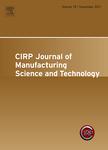版权所有:内蒙古大学图书馆 技术提供:维普资讯• 智图
内蒙古自治区呼和浩特市赛罕区大学西街235号 邮编: 010021

作者机构:Botswana Int Univ Sci & Technol Dept Mech Energy & Ind Engn Palapye Botswana Botswana Int Univ Sci & Technol UNESCO Chair Sustainable Mfg & Innovat Technol UCo Private Mailbag 16 Palapye Botswana Botswana Int Univ Sci & Technol Adv Mfg & Engn Educ AMEE Res Grp Palapye Botswana Botswana Int Univ Sci & Technol Dept Chem Mat & Met Engn Palapye Botswana Fed Univ Technol Dept Mat & Met Engn Minna Nigeria Nelson Mandela Univ Dept Mech Engn Port Elizabeth South Africa CSIR Laser Enabled Mfg Res Grp Pretoria South Africa MTL BldgRoom 038 ZA-6001 Port Elizabeth Eastern Cape South Africa CSIR Pretoria South Africa
出 版 物:《CIRP JOURNAL OF MANUFACTURING SCIENCE AND TECHNOLOGY》 (CIRP J. Manuf. Sci. Technol.)
年 卷 期:2025年第60卷
页 面:165-181页
核心收录:
基 金:Education, Audiovisual and Culture Executive Agency (EACEA) [2019-1973/5, 614655] Botswana International University of Science and Technology (BIUST) [DVC/RDI/2/1/7V (143)] African Laser Centre (ALC) [HLHA23X task ALC-R016]
主 题:Metal matrix composites (MMCs) Two-step laser-based remanufacturing Laser cladding Gas metal arc welding (GMAW) overlay Hybridisation effect Solid solution strengthening TiC umbrella-like network
摘 要:The premature failure of continuous miner cutter (CMC) sleeves in underground coal mining necessitates remanufacturing to enable a closed-loop system and enhanced sustainable mining operations. However, a techno-economic analysis conducted revealed that exclusively using laser cladding (LC) to remanufacture failed sleeves is not economically viable. Thus, this research aims to explore a two-step laser-based remanufacturing technique that incorporates gas metal arc welding (GMAW) and LC, as well as identify suitable wear-resistant metal matrix composites (MMCs) for restoring damaged sleeves. Consequently, an LC process was used to deposit three MMC materials onto optimised GMAW overlays. A comparative analysis of the manufactured MMC coatings revealed that WC/TiC/AISI4340 coating exhibited a well-consolidated, crack-and pore-free microstructure and a superior microhardness of 931 HV0.5 compared to WC-and TiC-reinforced composites, which had average hardness values of 670 HV0.5 and 744 HV0.5, respectively. Additionally, the WC/TiC/AISI4340 coating demonstrated an excellent low wear rate (0.0007 g/s) comparable to TiC-reinforced coating, and a propensity to extend the sleeve s lifespan by a factor of four. These enhancements are attributed to the formation of an umbrella-like network of TiC, predominantly distributed in the coating top region and solid solution strengthening [(Ti, W)C] caused by the partial dissolution of WC/TiC carbides and their precipitation into the eutectic carbide network within the interdendritic grain regions. Hence, combining GMAW and LC processes with WC/TiC/AISI4340 presents a promising remanufacturing strategy for restoring mining equipment, offering improved performance, longer lifespan, and economically viable and sustainable mining operations.